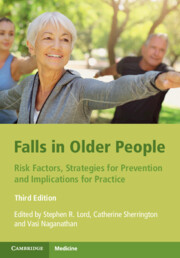Book contents
- Falls in Older People
- Falls in Older People
- Copyright page
- Contents
- Preface
- Contributors
- Part I Epidemiology and Risk Factors for Falls
- Part II Strategies for Prevention
- Part III Implications for Practice
- 28 Strategies to Promote Uptake and Adherence to Fall Prevention Programmes
- 29 Translating Fall Prevention Research into Practice
- 30 Interventions Reduce Falls, but What Is the Cost for Better Health Outcomes?
- 31 Bringing It All Together
- Index
- References
29 - Translating Fall Prevention Research into Practice
from Part III - Implications for Practice
Published online by Cambridge University Press: 04 November 2021
- Falls in Older People
- Falls in Older People
- Copyright page
- Contents
- Preface
- Contributors
- Part I Epidemiology and Risk Factors for Falls
- Part II Strategies for Prevention
- Part III Implications for Practice
- 28 Strategies to Promote Uptake and Adherence to Fall Prevention Programmes
- 29 Translating Fall Prevention Research into Practice
- 30 Interventions Reduce Falls, but What Is the Cost for Better Health Outcomes?
- 31 Bringing It All Together
- Index
- References
Summary
Generating a comprehensive body of high-quality evidence that demonstrates the problem of falls, identifies causal mechanisms and risk factors, and determines effective interventions for reducing falls is critical for establishing a strong foundation on which to reduce the global burden of falls. While the establishment of such an evidence base is absolutely necessary, this alone will not have an impact on incidence of falls. Assumptions should not be made about the diffusion of fall prevention evidence into clinical practices and health systems [1]. There is growing recognition that most efforts to date attempting to incorporate health research into health care practices and policies are grossly ineffective, and thereby, inefficient [2, 3]. The challenges of moving health evidence into care practices and decision-making are not unique to fall prevention. In fact, published reports have estimated that there is a 17-year time lag between established health evidence reaching clinical practice [3].
- Type
- Chapter
- Information
- Falls in Older PeopleRisk Factors, Strategies for Prevention and Implications for Practice, pp. 436 - 459Publisher: Cambridge University PressPrint publication year: 2021



